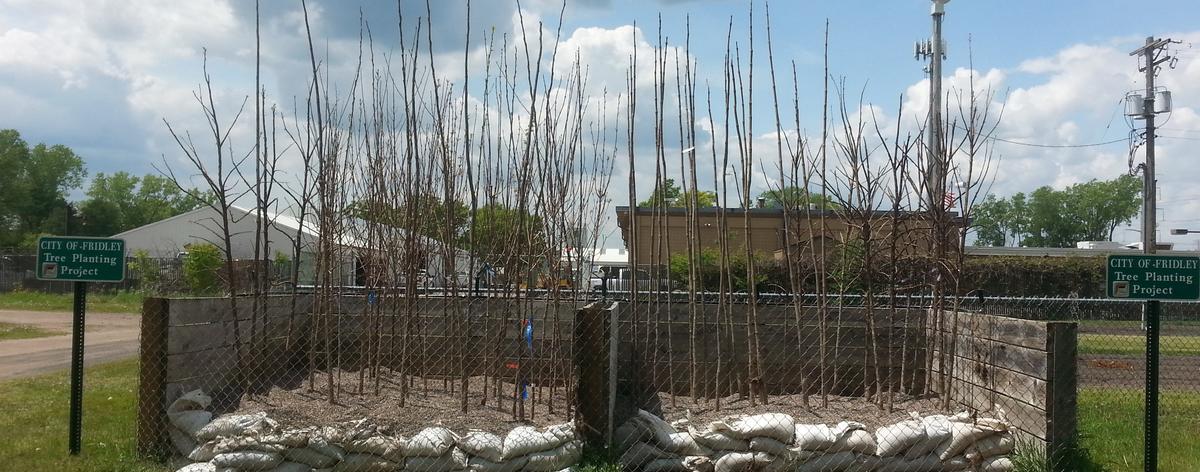
Welcome to the new feature on the University of Minnesota’s Urban Forestry Outreach and Research website’s section on community gravel beds.
Specifically, Gravel Bed “Community Stories” is intended to share information, experiences, success stories, and lessons learned with others that either have community gravel beds, are considering expanding or modifying them, or are now considering the option for reforesting their community. To that end, “interviews” with selected community gravel bed managers have been conducted and those responses and ideas are now available to you.
If you have a gravel bed and wish to share your experiences and methods, please join us by either clicking on the link to access the “interview,” complete and submit it to us or contact Gary Johnson at [email protected], and an interview will be sent directly to you. The more community stories we can gather and publish, the more we will all benefit.
Robbinsdale, Minnesota
History of your gravel bed
The inspiration to construct a gravel bed came from the newly hired Robbinsdale Forester/Natural Resources Specialist and City Engineering staff, seeking a less expensive and more “organic” way to plant public trees. For years the City had been spending many thousands of dollars a year on costly B&B trees and contracted planting labor. This expensive method of reforestation limited the number of new trees the city could plant and number of diseased elms that could be readily replaced. The less than stellar survival rate of B&B trees and desire to plant in-house further justified a different system.
The Robbinsdale Forester/Natural Resources Specialist first learned about gravel beds in Gary Johnson’s U of M arboriculture class, but really became familiar with gravel beds as a forestry technician in another nearby Twin Cities suburb that had just built one of their own. The designer of this gravel bed was also a former student of Gary’s.
For the most part, only the City Forester/Natural Resources Specialist has been involved with our gravel bed. The only exception is several hours each spring when new bareroot trees are delivered Public Works staff help with the bareroot tree installation, along with occasional technical assistance with irrigation during the growing season. Our gravel bed has been in continuous use since June, 2015.
The structure and mechanics of the gravel bed
The gravel bed is sited at our public works facility, located on the far west end of the complex, and well away from the most public area. Five feet to the west of the bed is the border with an adjacent municipality and large open park, nearest to the park’s hockey rink.
The entire facility is fenced in aside from three separate gates. The nearest gate is locked all the time, and the other two are on the opposite end of the facility and closed outside of business hours. We have never had issues with deer, and fortunately no vandalism. The bed receives shade until mid-morning from an adjacent pole barn. After the sun clears the barn’s roof until early afternoon the bed receives full sun. Afterwards the northern half of the gravel bed receives partial shade from a trio of Austrian pines growing on the edge of the adjacent park. The gravel bed is on a concrete pad, sloped at a very slight angle to allow for water drainage.
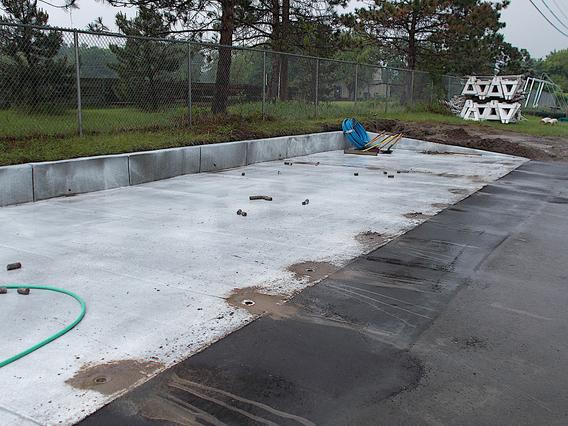
Our gravel bed is a combination of wood and concrete. The long side adjacent to the city border on the west is a 24” high concrete wall that spans 66’. The other 3 sides that define the border of the gravel are constructed of doubly-stacked 2” x 8” treated wooden boards. The wooden long side is constructed with four sets of these interlocking boards that are each 12’ long, making for a height of 16” and length of 48’. The two shorter sides are constructed identically but are 14’ long, making for a 14’ overall width. One of the two shorter sides is always kept open, so it’s essentially a 3-sided gravelbed from tree installation in late May until tree harvesting starts in September. At this time, the long board side is removed for allow for easier harvesting access.
Two top-mounted handles and 3 pipes are bolted onto each stacked board set. These pipes slide 10” into cores drilled into the concrete for anchorage. Each stacked board has a “U” rail on the end to allow for a snug fit, which helps to effectively hold in the gravel. Both the concrete pad and wall were constructed specifically for the gravel bed. Photos taken of the bed as it was nearing construction will be provided.
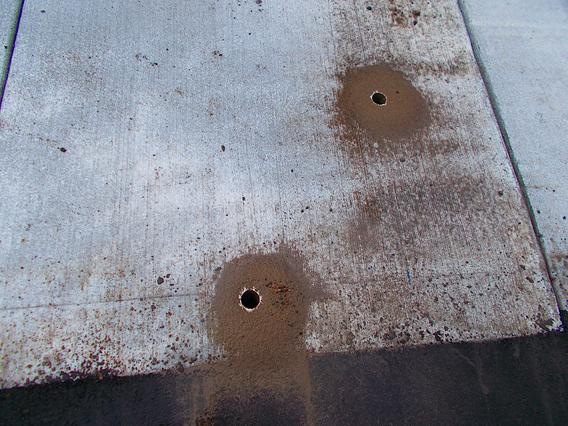
The shape is rectangular. The fully enclosed dimensions are 14’ x 48’, so 672 square ft. However, since one of the short sides are continuously kept open allowing for another ~6’ of gravel and plants, the actual “in service” square footage of the bed is closer to 750 square feet.
Growth medium is 3/8” buckshot (pea gravel), filled to a depth of ~14” high. This equates to roughly 850 cubic feet of gravel, with a pile of some extra gravel set aside to spare. After ~5 years we incorporated a load of 3/4” round river rock to try to create some larger porous space, and replenish some of the original pea gravel that had been lost over years of use. No sand, clay or other amendments have ever been added in.
Irrigation water is from the city’s water system, which is well-based. The distance between the gravel bed and its water source is roughly 11 feet, which is the location of the yard hydrant and water main servicing the irrigation system. Both the yard hydrant and water main extension were built for the gravel bed. Aside from the normal water treatment there is no filtering.
There are 6 pop-up irrigation spray heads placed equidistantly for the length of the bed above the concrete wall side. Each head articulates its spray area in a 180-degree coverage pattern, with adjustable spray heights. The irrigation controller unit is housed in a ground-installed box several feet from the yard hydrant. Irrigation equipment brand is Hunter. It is not a recirculating system.
Management of the gravel bed
Q. What is the stocking level of your gravel bed?
A. It is usually stock at around 200 trees, give or take a few. Trees are placed in rows of 8 across the short 14’ side. Stocking is performed 4 trees at a time, with two people holding the four trees and a skid steer dumping a bucket load of pea gravel onto the roots, working front to back until all trees are in gravel. We also usually order 10 Red Lake currant shrubs that are placed on the far open (north) end of the gravel bed.
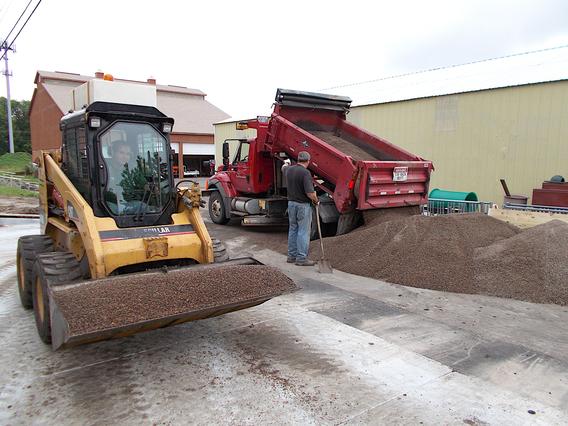
Q. When do you stock the gravel bed?
A. The bed is usually stocked during the 3rd or 4th week of May. This allows us to plant out overwintered trees. The earliest has been mid-May. We have never tried sweating trees, but we suspect the roots being in constantly irrigated moist pea gravel may partially mimic sweating, combined with the relatively late date of spring tree delivery.
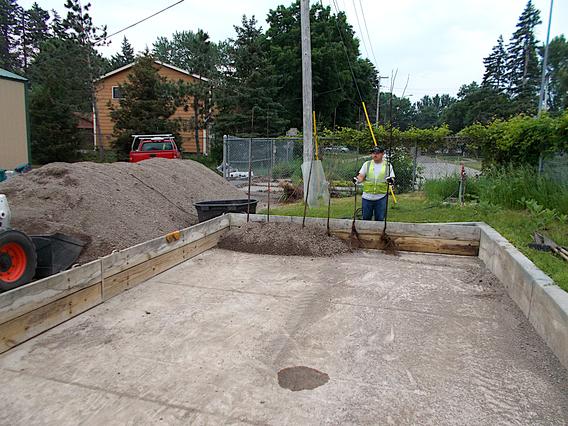
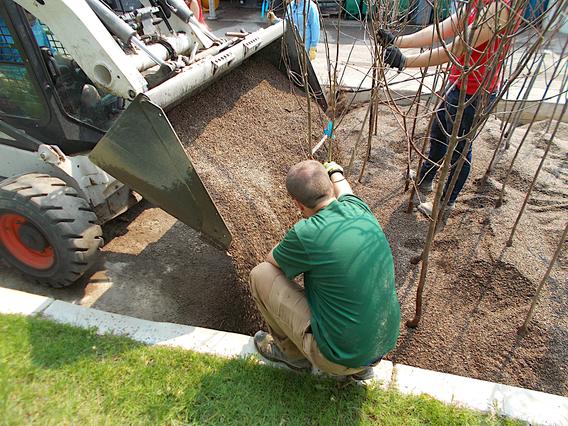
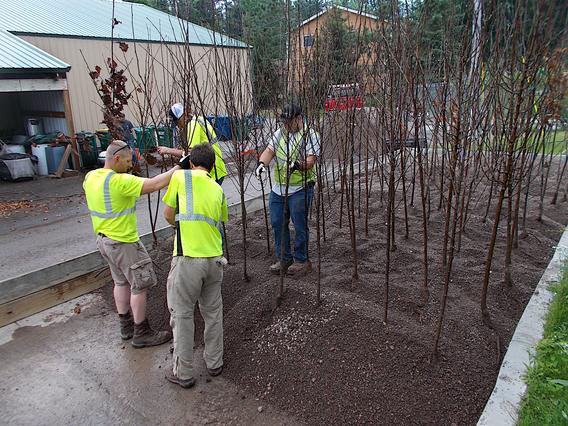
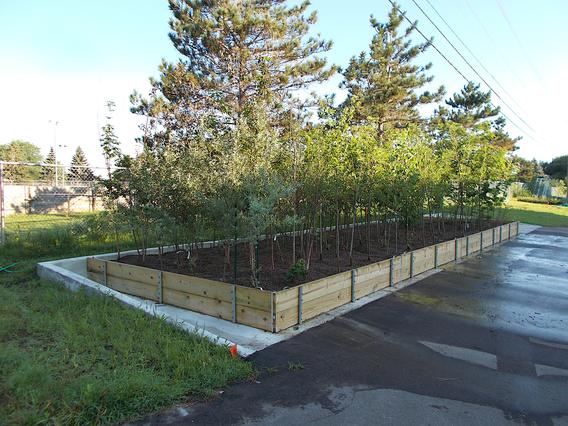
Photos by Stephan Papiz
Q. How often does the gravel bed get irrigated?
A. The controller is automatically designed for 4 separate watering times a day. During early to mid-summer we run up to 18 minutes per interval until new trees have leafed out (to mimic sweating and make sure trees have as much water as possible coming out of dormancy). Watering time is decreased closer to ~12-15 minutes once all the trees are leafed out, depending on the temperature and rainfall frequency. In late summer we decrease run times to 8-10 minutes per interval, and then down to 5 minutes around the fall equinox. Irrigation runs at 7am, 12:30pm, 5:30pm and midnight, and is winterized by Public works staff in mid-October before nightly hard freezes. After this time, remaining trees are simply hand watered via a garden hose connected to the yard hydrant until winter and also the following spring. Roughly 100,000 gallons of water are used annually, with excess runoff trickling to a nearby detention pond on the facility grounds.
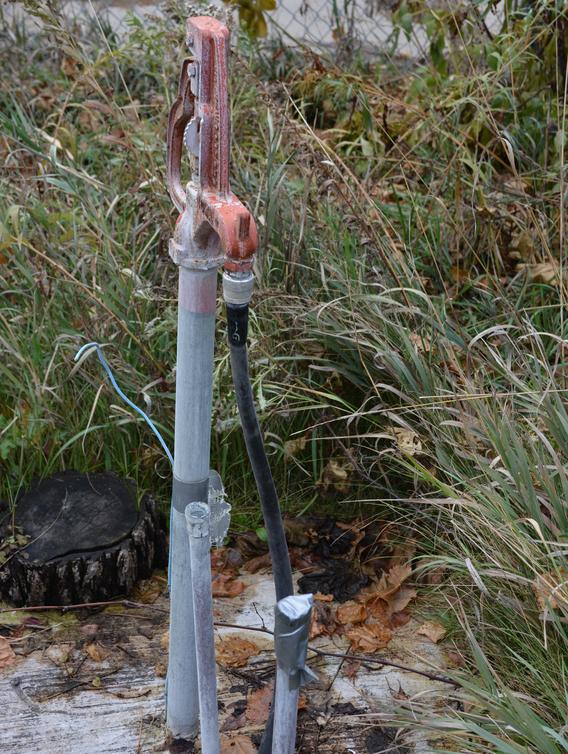
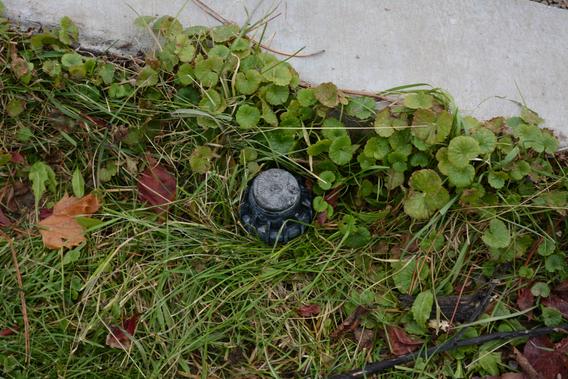
Q. Do you add any amendments to the gravel bed?
A. We’ve never tried amendments. Weeds and old decaying roots that broke off in harvesting provide some organic matter, but as many of these old roots are pulled out whenever possible to keep the gravel abiotic.
Q. Are weeds controlled in the gravel bed? If so, how?
A. The occasional weed is pulled by hand and tossed aside in summer, but there is no concerted effort to pull them. There were weeds the last two seasons since some trees had sparser canopies, mostly dandelions, plantains and smartweeds. Usually in the process of harvesting weeds are disturbed enough where they are easy to remove at that time. A related operation we do every fall is use a backpack blower to clear out leaves and fallen Austrian pine needles from the gravel bed.
Q. Are animals a problem, e.g., rabbits, deer, voles, field mice, ground squirrels?
A. A few trees have been lost over the years due to small animal damage, likely from rabbits, particularly on trees in the Prunus & Malus genus.
Q. If animals are a problems, are any protective devices used to minimize animal damage, such as rabbit fencing, stem guards?
A. We place stem guards/bark protectors on for the winter when the landscape starts to go dormant to prevent small animal damage, usually in late September/early October. This year damage was observed on a couple trees in mid-summer, resulting in a full girdling of the stem. We use 31” high mesh tree guards to allow for better air flow for the bark.
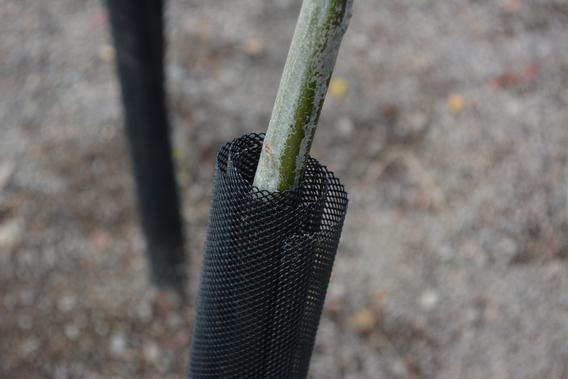
Q. Have you experienced any disease or insect problems on the plants in the gravel bed? If so, have you controlled them?
A. The primary insect issue in the past has been Japanese beetle damage. There isn’t much that can practically be done about this. We’ll shake trees being defoliated to get the beetles to fly away and hopefully not return. Elms, basswoods and fruit trees seem to incur the worst beetle damage. There was leaf curl in this past season, mostly on Amur maackia. In the last 3 severe drought years leaf margin dieback, most likely from abnormal strings of hot sunny days in early summer, was a health issue on some species placed in the sunnier half of the gravel bed. Some trees exhibited top leader dieback as they broke dormancy, particularly on honeylocusts in 2022 and on a few coffeetrees.
Plant materials
Q. What trees/shrubs have you held in your gravel bed?
A. We have tried just about everything available from a large well-known local nursery that is rated for Zone 4 cold hardiness, outside of the genus Fraxinus, Juglans or Carya. The only shrubs we regularly stock are Red Lake red currants.
Species that we have stocked most every year include coffeetree (species), northern catalpa, hackberry, American elm (St. Croix & Valley Forge), Accolade elm, honeylocust, river birch, Snowbird hawthorn, Princess Kay plum, crabapples (Dolgo & Prairiefire), Japanese tree lilac, Siouxland poplar, quaking aspen, Amur chokecherry, bur oak, northern red oak, northern pin oak, swamp white oak, and ironwood.
In only two years did we have maples – Green Mountain sugar and red. In previous years we tried some smaller true sycamores which did fine in the gravel, similar to London planetree, but fair landscape survivability. One species that succeeded in the gravel bed but proved to be mostly a failure in the landscape was Kiwi Sunset zelkova. We would love to try hickories and walnuts but they are hard to come by in the nursery trade. The species column in the attached spreadsheet lists all species tried since 2015.
Q. What sizes of trees have you held?
A. Most trees have been between 5’ and 8’ size, and seldomly up to 1” (mainly Ohio buckeye), depending on availability, preferring lightly branched grade. In the case of catalpas and coffeetrees it’s usually whips. We’ve had ‘boulevard plantable’ trees as small as 4’, and the largest was graded at 1¼” caliper.
Q. Have you stocked any pot-bound, containerized trees or shrubs in your gravel bed as a method of developing expansive, non-encircling roots?
A. Nope.
Harvesting plant materials
Q. How long do you leave plants in the gravel bed before harvesting?
A. Trees are held in our gravel bed no less than 3.75 months, or ~18 weeks. Over the last 9 seasons the average beginning date for fall planting has been the 26th of September, with an average end date of November 28th, so an average of 23 weeks for fall planted trees. Trees that are overwintered average a 10.5-11.5 month stay in gravel.
The only species we specifically overwinter is river birch since this species is a near guaranteed failure if planted after mid-September. All other species are generally random in terms of their duration in gravel. Since we heavily favor coffeetree as a go to species, most get planted out before winter. Elms and planetrees are easier to extract later in the fall or spring after some harvesting has occurred due to their dense & extensive fibrous root system. Trees that looked the best during the growing season are planted out first, so if there is any selectivity in terms of minimized length of time in gravel it would be trees with the healthiest canopies.
Q. How do you harvest the plant materials?
A. Primary method is by using a spade shovel, excavating out (undercutting) from under the tree. Care is taken to not shear off lateral roots or ding the bark on trunk roots. When access is possible, an adjustable skid steer forks attachment (forks moved close together to create a lifting mechanism) is used to harvest species such as elms, river birch, planetrees or Japanese tree lilacs that grow highly extensive root systems. Previously, trees would be pried up with a long-handled pitchfork or a custom-welded, metal-handled heavy-duty railroad ballast fork, combined with a metal bar for leverage. Recently, however, undercutting has proven to be more practical and less taxing.
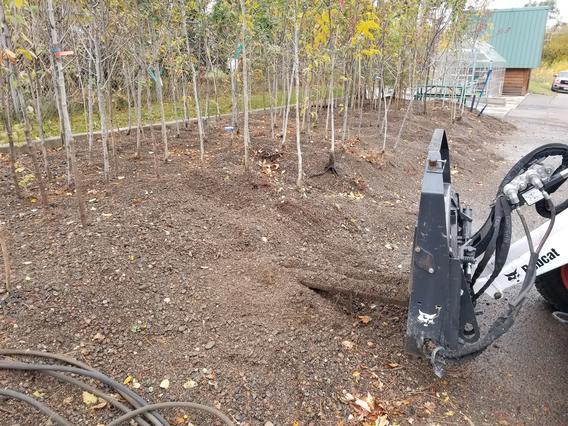
Q. When plants are harvested, how are the roots protected from drying out?
A. Initially roots are washed off with a garden hose nozzle and then dipped in fine grade hydrogel. We utilize a 100-gallon stock tank to hold the hydrogel, usually kept filled up to 75-gallons. Trees are then laid flat on the rear box of our skid steer machine (Toolcat), with roots covered by a large drenched cloth canvas. This has been our go-to method for root protection since 2015, and has proven to be effective at keeping roots moist, even on 85+ degree days.
Occasionally there is a scenario where only a single tree is to be planted where a skid steer auger is not needed for excavating the planting hole. In such cases, the roots are still dipped in hydrogel but then placed in a contractor-grade garbage bag and transported via pickup truck.
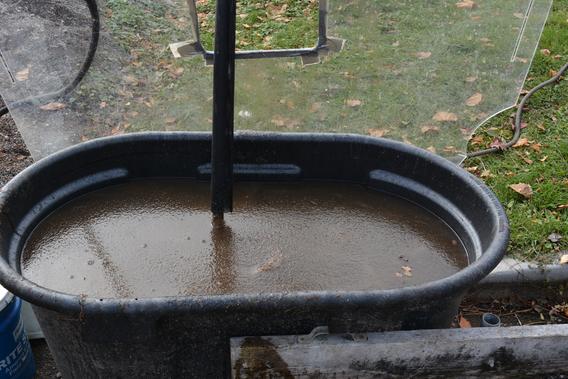
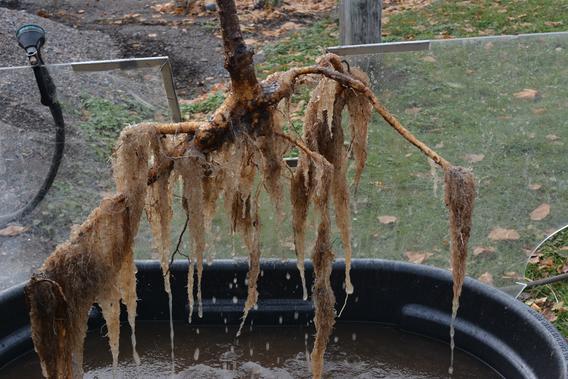
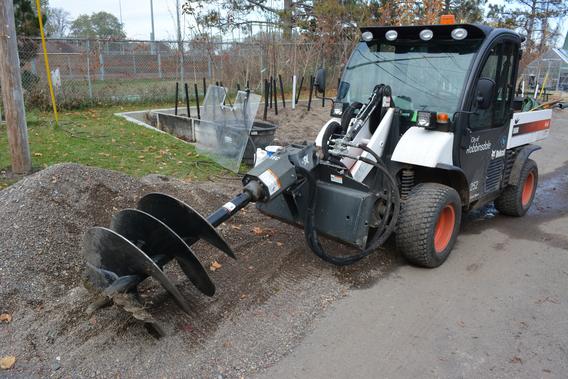
Measurements of success
Q. Generally, how well did plant materials survive and perform in gravel?
A. In-gravel bed performance usually depends on species and to a lesser extent the stock year. Up until 2022, generally speaking, performance in gravel was very good, and survival excellent (>95%). Some species, such as quaking aspen, Siouxland poplar, Purple Robe locust (2015) and Russian olive (2015-2017) actually put on both measurable canopy and caliper growth during their short stay in gravel. Even a few swamp white oaks will send up a 2nd flush of new canopy growth by late summer, which is uncommon even on elms.
Since 2022 survivability and performance could be characterized as adequate to good. In 2022 there were 10-15 trees that didn’t leaf out, incurred leader dieback, or had sparser than normal foliage, with slightly better results in 2023. One annual constant is that bur oaks could be categorized as poor, with small leaves and basically no fibrous root growth. See our spreadsheet listing species specific gravel bed performance.
Q. Generally, what was the survival rate of planted gravel bed trees/shrubs one year after planting (by species if possible)?
A. Prior to 2022 survival rates could be rated as very good, but successive years of severe drought has led to a general decline in this metric. The attached spreadsheet lists each species’ general one-year post planting survivability rating, along with some other notes about their experiences in gravel.
Q. If survival rates were low, do you have an opinion of why the rates were low?
A. The last three years of severe droughts have led to lower survival rates, likely compounded by inadequate watering by residents for unrequested trees planted in boulevards. The dryness in June and July has been particularly impactful on new tree survival (especially spring-planted) due to the high evaporation rates.
One exotic species that successfully established (but minimal sample size) was an Osage orange planted in an out of the way spot on DOT right of way. The source was from a batch of 2’ conservation grade stock. This tree has thrived, survived -29 degrees in January 2019, and is possibly a species that holds great potential for local (southern Minnesota) landscapes.
Lessons learned
In our experience only a few select species would be called “incompatible” for use in gravel beds. It is hard to envision any other method for municipal reforestation when one considers the relative cost of bareroot trees and the ease with which they can be planted with in-house staff, in many cases solo. Even species that traditionally do not develop many fibrous roots will, for the most part, transplant OK if adequately watered (and trend towards a smaller size). We have not seen any significant dieback on trees that are overwintered in the gravel bed. The only disappointment with this system has been the perpetual struggles of bur oak and, to a lesser extent, northern pin & red oaks, almost regardless of stock size.
Photos














*Photos by Stephan Papiz
Species list
Contact information
Bloomington, Minnesota
History of your gravel bed
The beginning of our Emerald Ash Borer infestation was a wakeup call that we would need a more robust system to get trees replanted throughout our parks. We had known about gravel beds through classes and seminars. The gravel bed was built and has been maintained by multiple Park Maintenance staff. Irrigation was installed by our irrigation and turf specialist, blocking and fill were installed by maintenance staff. Follow up maintenance and planting has been carried out by fulltime and seasonal staff for almost ten years.
The structure and mechanics of the gravel bed
The gravel bed is located in the field where our previous tree nursery was; at our Western Maintenance facility. The location gets full sun, and sits over soil. It is in an area of low traffic, so it has typically only been fenced towards the end of summer to discourage deer damage. In the last two years we have left it open, but installed individual tree guards in the spring to protect them until planted out.
The sides are constructed using a single level of 2’x2’x6’ concrete bin blocks. 12 blocks long, 6 blocks wide, (11 blocks long in the middle).The growing medium was installed without a fabric barrier, so some drift has been happening, and an additional tandem load of pea gravel has been added.
The original half was a U, but as we added capacity it became a W. Square footage is roughly 2,400 ft2.
The first bin was created using a pea gravel and sand mix, roughly 85/15. The second bin was filled using only the washed pea gravel.
The water source is from the city water system. The gravel bed sits roughly 40-50 yards from the water riser/ meter. The line runs back under ground to the control box.
The irrigation is a battery programmed pop-up head system. The heads are on metal posts that are roughly 3.5’ in height.
Management of the gravel bed
In its expanded form, the most trees stocked was 400 (1”-1.5” bare-root). We planted out 400 trees a handful of years to reforest the heavy initial losses in parks, but have consistently averaged roughly 250-300 trees a year. (I believe the greater spacing makes removal easier, as well as reducing impacts of shading.)
Trees are stocked every May.
The irrigation typically runs between 5 and 7 minutes- 3 to 5 times a day. I have experimented with different schedules over the years. I monitor depth of moisture before and after. (It’s surprising how well it holds moisture, even when the top inch looks dry and chalky.) When stocking species prone to rust/ leaf blights I try to reduce the frequency of watering’s to reduce the amount of time the leaves are wet.
Weeds are controlled via pulling and propane torch.
Typically the only trouble with critter damage is deer scraping of the bark. Snow fencing was installed in September previously, but the last two years we have installed trunk protection right away in the spring.
In terms of diseases and insect pests, forest Tent Caterpillars a couple times (two infested trees removed, successfully controlled). Rust on hawthorns unfortunately not treated successfully. Scorch on Buckeye (reduced watering frequency (overall tree health recovered/ not fatal).
Plant materials
Q. What trees/shrubs have you held in your gravel bed, e.g., sugar maples, bur oaks, common lilacs?
A. Bur oak, White oak, Red oak, Swamp White oak, Musclewood, River birch, Buckeye, Cherry, various Crabapples, DED resistant Elms, Hackberry, Hawthorn, Horse chestnut, Linden (European and American), Honeylocust, Red maple, Sugar maple, London Plane tree, Serviceberry, Yellowwood, Tuliptree, Tree lilac, Turkish hazel, and probably a couple more I’m forgetting.
Q. What sizes of trees have you held? What sizes of shrubs have you held?
A. Only trees, between 1-1.5” diameter, bare root (some are 4’ tall, some have been 7-8’).
Q. Have you stocked any pot-bound, containerized trees or shrubs in your gravel bed as a method of developing expansive, non-encircling roots?
A. We have not. We placed them nearby for a convenient holding location and to water when needed.
Harvesting plant materials
Q. How long do you leave plants in the gravel bed before harvesting? If the length of time is species-specific, could you provide examples? For instance, elms are harvested after 10 weeks in gravel.
A. No set timing on harvest. Typically bulk planting isn’t feasible until October. We have tried planting out the White and Bur oaks earlier though. Watering difficulties in the summer limit planting to small replacement projects. Typically harvesting is done by hand so as to diversify what is planted out. Undermining, uncovering with spades, sometimes pitchfork for leverage under roots, then hand pulling.
Tractor/ loader removal requires additional space to operate, or in other words fuller scale emptying of the beds. When we have a larger crew we can do this and typically have used a forklift fork on our mini-loader to pry/ shake up trees.
Q. When plants are harvested, how are the roots protected from drying out? For instance are they placed in plastic bags, or the roots are covered with wet burlap/straw/excelsior and placed under a tarp, roots are dipped in a hydro-gel solution?
A. Speed and dampening before driving to the planting location (only pulling trees that we can plant immediately). (Holes are already augured and ready for planting.)
Measurements of success
Q. Generally, how well did plant materials survive and perform in gravel?
A. Bur oak- Adequate/Poor, White oak- Adequate, Red oak- Good, Swamp White oak- Very good, Musclewood- Good, River birch- Adequate, Buckeye- Good, Cherry-Adequate, various Crabapples- Good, DED resistant Elms- Very Good, Hackberry- Good (if placed on furthest south row), Hawthorn- Adequate, Horse chestnut- Good, Linden (European and American)- Adequate, Honeylocust- Very good, Red maple- Good, Sugar maple- Good, London Plane tree- Very good, Serviceberry- Adequate, Yellowwood- Good, Tuliptree- Very good, Tree lilac- Very Good, Turkish hazel- Good.
Q. Generally, what was the survival rate of planted gravel bed trees/shrubs one year after planting (by species if possible)?
A. If planted in moderate temps- 90-95%. If planted late, temps 30 to 40 degree range- 70-80%.
Q. If survival rates were low, do you have an opinion of why the rates were low?
My theory is relative moisture in air is lower (drying), likelihood of cold shock/freeze is much higher. Overall it’s equivalent in stress to planting during a drought without a watering plan.
Lessons learned
I think if we were to build a new gravel bed…
- I would use fabric to separate ground from pea gravel.
- Straight pea gravel for easier harvest (moisture seem to stay just fine in pure pea gravel –maybe because it’s over soil)
- Emitter system rather than heads, or a lower mounting system to minimize problems caused by moisture on leaves.
Video
Watch Bloomington's gravel bed process here:
Contact information
Grand Junction, Colorado
History of your gravel bed
The idea to construct Grand Junction’s (western slope municipality of Colorado) bare root tree production beds originated from a combination of City Forester experience and testing performed by GJ arborists. GJ’s City Forester met Professor Johnson at a conference back in the early 2010’s and both discussed experience and interest in gravel beds, and the overall desire to plant trees with a more “true to nature” root system. This conversation further fueled the City Forester’s desire to bring a gravel bed system into a municipal forestry tree planting program.
Grand Junction hired on this City Forester in 2019 and he was drawn to the City’s aquaponics greenhouse grow system. City Arborists presented a young catalpa tree that they had bare rooted from its #1 container and submerged into the greenhouse’s aquaponics media. The one-year growth of the tree was outstanding, and the idea to create a unique gravel bed started to grow.
The City of GJ applied for a 2020 grant through the Colorado Tree Coalition with the concept of constructing a one of a kind aquaponic bare root tree production bed. The concept was modeled after indoor greenhouse systems but modified to create an outdoor bed system for trees. The system was constructed in the later winter of 2020 with its first crop of trees installed that April. The beds have now produced trees for the City’s fall planting program four times from 2020 through 2023.
The structure and mechanics of the gravel bed
With the help of GJ Park Operations staff, GJ Forestry staff constructed four 20 ft x 6 ft x 24 inch raised production beds, and an adjacent indoor fish tank system on the grounds of GJ’s Park Operations maintenance facility. The raised beds were lined with a plastic pond liner and filled with an expanded clay hydroponic growing media called hydroton. The beds are in a full sun location and are within the fenced yard of the maintenance facility.
The construction of these beds was a bit more complicated, and photos make it easier to understand (yes happy to share photos). This system hinges on a large 1,000-gallon water tank
(sump) that holds a large amount of water to support the beds. This sump has a pump that pushes water through 2” pvc pipe to the high-ends of each gravel bed, and then the beds have drains on the lower-ends that return to the sump. This allows for a constant water flow from the sump, through the beds, and then back to the sump. Within an adjacent shed, a large fish tank and filtration system was installed, and the fish waste was added to the main sump of the system with the intention of adding nutrients to the water. The only water loss associated with this system comes from tree use, transpiration, and evaporation.
Q. What is the shape and square footage of the gravel bed?
A. 20 ft x 6 ft x 24 in
Q. What is the growth medium? Examples could be washed pea stone 3/8 diameter or less, angular stone larger than 3/8 diameter, stone plus an amendment such as coarse sand or expanded clay.
A. Expanded clay; Hydroton® is the product used.
Q. Water source. Is the water source from a well or city water system? How close to the gravel bed is the water source? Is it filtered?
A. Treated city water is used as the supply for the system, and there is a frost free hose bib adjacent to the sump.
Q. Irrigation. How is the bed irrigated? For instance, hand-watering, soaker hoses, pop-up spray heads, drip and/or trickle systems, recirculating systems?
A. The bed is irrigated through a recirculating system.
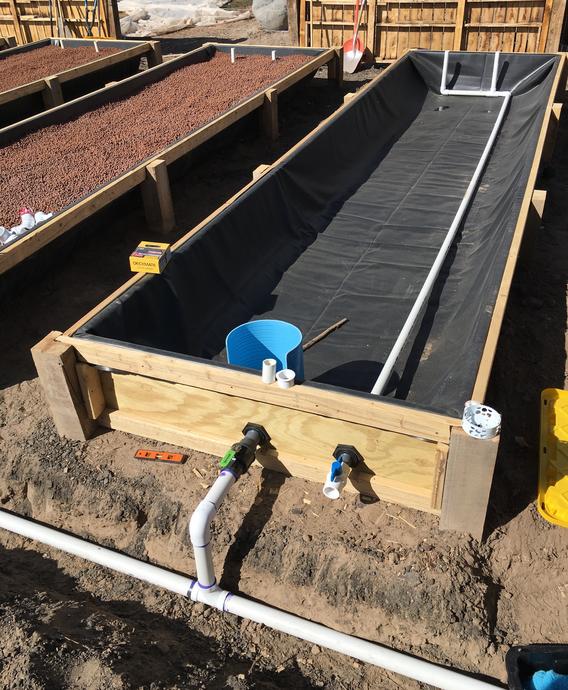
Management of the gravel bed
Q. What is the stocking level of your gravel bed, that is, how many trees/shrubs do you usually stock it with?
A. The beds can hold ~100 1” branched bare root trees.
Q. When do you stock the gravel bed, e.g., April, May, June…?
A. Bare root trees are received in early April, and the buried into the media.
Q. How often does the gravel bed get irrigated? What is the length of the irrigation time? For instance, irrigation comes on three times a day for 15 minutes at each interval.
A. The trees are in a constant flow of water all season.
Q. Do you add any amendments to the gravel bed, e.g, fertilizer?
A. The original design of the bed used fish waste as the supply of nutrients. In 2022 the challenge of keeping fish happy, and we moved away from an aquaponic system to a straight hydroponic system (fish tank system was eliminated). In 2022 and 2023 the system was run with no additional nutrients added. Trees did not show signs of nutrient deficiency, but we are considering adding nutrients to the hydroponic system.
Q. Are weeds controlled in the gravel bed? If so, how?
A. Weeds / tree volunteers are easily pulled from the media as needed.
Q. Are animals a problem, e.g., rabbits, deer, voles, field mice, ground squirrels?
A. We’ve not experienced animal damage, and the real challenge we faced was keeping trees upright through summer wind / storms. We had to develop a lattice system for staking the trees upright in the beds.
Q. Have you experienced any disease or insect problems on the plants in the gravel bed? If so, have you controlled them?
A. N/A
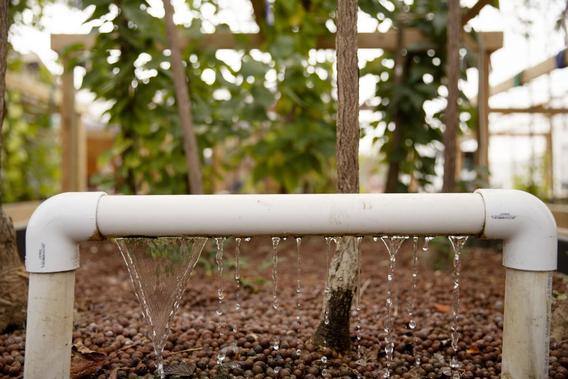
Close-up of irrigation.
Photo credit: Rob Davis
Plant materials
Q. What trees/shrubs have you held in your gravel bed, e.g., sugar maples, bur oaks, common lilacs?
A. See attached spreadsheet of trees used by year.
Q. What sizes of trees have you held? What sizes of shrubs have you held?
A. We target a 1-inch caliper lightly branched bare root tree; 6-8’ whip, and have used rooting hormone on cottonwood cuttings to produce small bare root native trees for our open space program.
Q. Have you stocked any pot-bound, containerized trees or shrubs in your gravel bed as a method of developing expansive, non-encircling roots?
A. We have taken a few pot bound smaller trees and bare rooted them into the system.
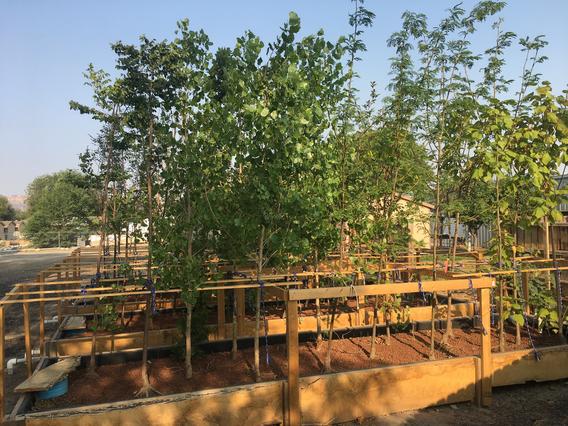
Bed with Hydroton Clay pebbles in lieu of gravel.
Photo credit: Rob Davis
Harvesting plant materials
Q. How long do you leave plants in the gravel bed before harvesting? If the length of time is species-specific, could you provide examples? For instance, elms are harvested after 10 weeks in gravel.
A. Standard practice: installation in April and harvesting in early November with a goal of pulling trees once trees enter early dormancy. We have accidentally discovered that trees are able
to successfully over winter in the beds, and we can pull them / plant in spring or allow another growing season. This year we received honeylocust that were very limited on branching, and we have decided to leave them in place for a second season to develop more fully.
Q. How do you harvest the plant materials? For instance, are they lifted by pulling them out, by undercutting and digging them out with shovels or forks, by using a front end loader to lift them out, a front end loader with a rock-picking bucket?
A. Drain on a bed is closed, allowing the bed to completely fill with water. Once filled, the trees can be much more easily pulled from the hydroton. Some species (cottonwoods can be a challenge to get out of the beds due to their massive root development).
Q. When plants are harvested, how are the roots protected from drying out? For instance are they placed in plastic bags, or the roots are covered with wet burlap/straw/excelsior and placed under a tarp, roots are dipped in a hydro-gel solution?
A. When trees are harvested, we pull a smaller number of trees and bury the roots in mulch for transport. Once trees are pulled, they are transported directly to the planting site and installed. We prep planting holes using City stump grinder which creates a finer media that easily covers/blends with root system. The stump grinder also allows staff to create wide shallow planting sites.
Measurements of success
Q. Generally, how well did plant materials survive and perform in gravel? This can be simply categorized as Very Good, Adequate, Poor (by species if possible).
A. We’ve seen success hinge heavily on species installed into the production beds. In year one we tried 2 different oak species and found zero success leading us to move away from further trying Quercus (all information pointed towards an expectation of limited success). Beyond oak, other species either had mixed results or performed well. To simplify the answer to this question, below are species that we’ve had the highest success in developing in the production beds (if not listed it indicates species where we’ve had mixed results). We are working to dial in strong success with a core group of species that we can limit from our spring orders, and will continue adding in a smaller number of experimental species annually.
Highest success: cottonwood, catalpa, London planetree, maple, crabapple, coffeetree, boxelder, pear, elm, goldenrain tree, and honelocust
Q. Generally, what was the survival rate of planted gravel bed trees/shrubs one year after planting (by species if possible)?
A. We have focused measuring success around the initial year one tree planting and have not put in time to track all species planted since fall of 2020. The year one planting was focused into one park in our system making it much easier to manage the time it takes to track success. I have an extensive set of presentations around these beds, and one created more recently that was part of a presentation for the Western Colorado Community Forestry Conference. As most of the presentation is pictures the file size requires a file transfer software to share. If interested let me know and I’ll find a way to pass it on. This presentation has pictures of trees taken in the spring of 2021 (first summer growing season in the ground) and compares to photos taken in summer of 2023. Of the trees that we successfully produced in year 1 and planted within Sherwood Park, we currently have a success rate of 80%. The more unique aspect of the success is the growth rate which is visible in the photos of the presentation I’ve referenced.
Q. If survival rates were low, do you have an opinion of why the rates were low?
A. We have had most losses within the grow beds as we’ve experimented with a wide range of species trying to better understand a path to success. We also tried planting in some areas without dedicated irrigation that also had lower in the ground success. In areas where there is dedicated turf irrigation systems we’ve see higher success.
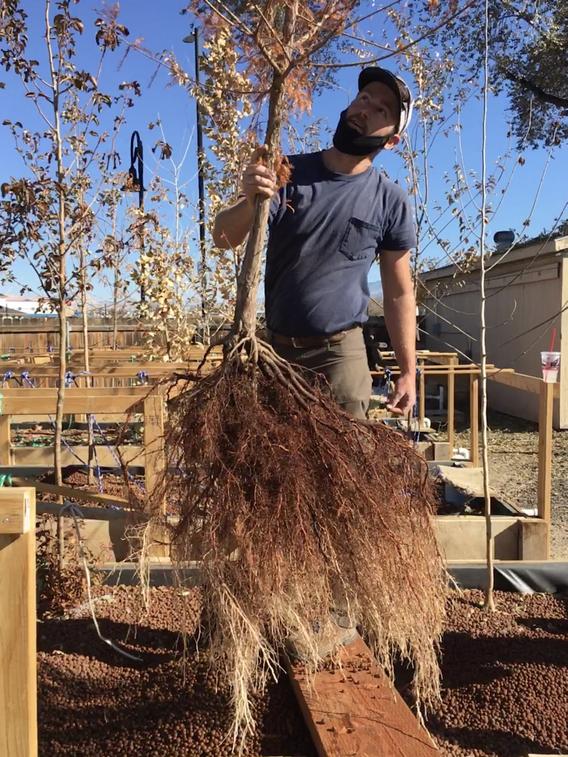
Example of gravel bed root system.
Photo credit: Rob Davis
Lessons learned
From what I’ve seen working on these beds, there are species that can have tremendous root development that has translated over into rapid growth in the landscape once installed. The challenge is developing a working system to maximize the species that we can work through this process. Grand Junction has very hot dry summers, and I believe allowing trees time to establish over the milder winters before moving into the heat of the summer should increase success. Bare root nursery stock is less expensive increasing number of stems planted, and moving a percentage of trees over to our fall planting window eases some time burden in our busy spring season. Forestry staff enjoy the bare root planting as labor is far less demanding. Sustainability divisions, elected officials, and media find interest in the beds drawing more attention to the benefits provided by trees and the programs responsible for community tree care.
Photos




All photos by Rob Davis.
Species list
Contact information
Racine, Wisconsin
History of your gravel bed
Prior to having a gravel bed, we purchased trees in both spring and the fall. The fall purchase was always challenging due to a lack of species availability and limitations due to ‘spring dig’ requirements. Our spring purchase consisted primarily of bare root trees and exploring the use of gravel beds made sense for us for financial reasons as well as for the root system benefits. Since 2015, the city forestry staff has been using the gravel bed we established, using online resources to size and construct it.
The structure and mechanics of the gravel bed
Our gravel bed is located between a city park and a city owned golf course. It is partially shaded by trees located to the south. It is on soil with a base of traffic bond gravel that needed to be refreshed annually the first couple of years due to settling and compressing into the soil. It is fenced in to minimize vandalism and protect against theft. It is rectangular and is approximately 5,200 square feet. We increased the footprint in fall 2023. It was previously about 3,100 square feet.
We use washed pea stone, initially incorporating 10% sand. We have had to purchase supplemental pea gravel a few times, especially during the first few years of operation but determined that the sand component did not need to be maintained. There is a fire hydrant located within 25 feet. It is not filtered. From 2015 to 2023 we used soaker hoses that were turned on and off by a Rainbird® controller. In mid-2023 we switched to ½ inch dripline combined with 0 to 10 gallon adjustable spray emitters. The soaker hoses were very high maintenance. We replaced them annually to reduce mid-season maintenance but we still had too many breaks to contend with.
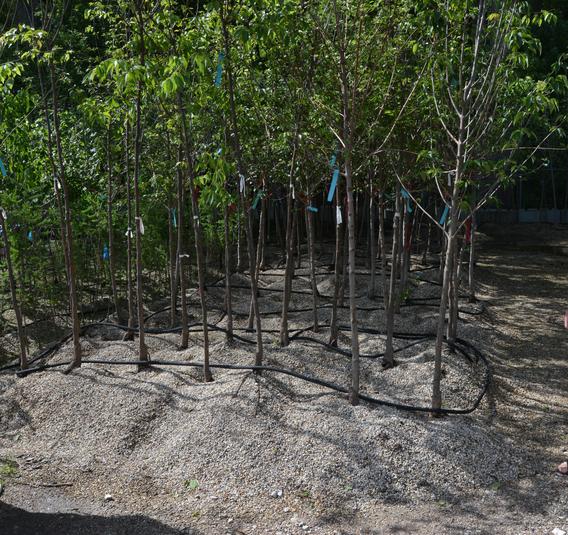
Stocked bed with irrigation.
Management of the gravel bed
Q. What is the stocking level of your gravel bed?
A. Most years see 350 to 400 1.5” to 1.75” caliper trees. In some years we have included an additional 250 to 500 whips and/or some seedlings.
Q. When do you stock the gravel bed?
A. Late April or early May
Q. How often does the gravel bed get irrigated? What is the length of the irrigation time?
A. Five (5) times per day. Length of time varies from 1 minutes to 5 minutes per cycle.
Q. Do you add any amendments to the gravel bed?
A. No.
Q. Are weeds controlled in the gravel bed? If so, how?
A. Yes, college students are responsible for pulling weeds by hand on a weekly basis during the summer months.
Q. Are animals a problem, e.g., rabbits, deer, voles, field mice, ground squirrels?
A. No.
Q. Have you experienced any disease or insect problems on the plants in the gravel bed? If so, have you controlled them?
A. We have experienced minor Japanese beetle infestations a few times (there is an adjacent golf course). We typically knock them off trees using a hose but have resorted to spraying pesticide also.
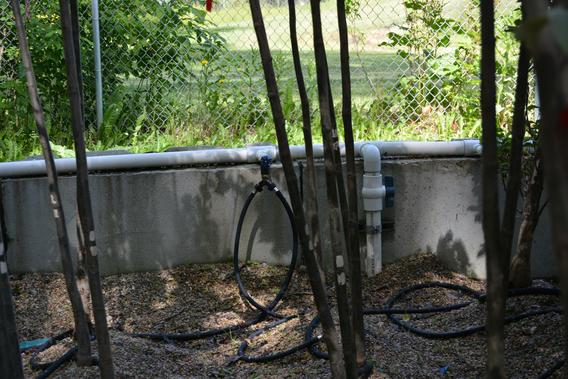
Close-up of irrigation and water source.
Plant materials
Q. What trees/shrubs have you held in your gravel bed?
A. This list is not exhaustive. We regularly install these species: cornelian dogwood cherry, spring flurry serviceberry, paperbark maple, flame maple, amur maackia, Japanese tree lilac, seven-son flower, ‘White Shield’ osage orange, planetree, coffeetree, elm, linden, honeylocust, freeman maples, red maple, sugar maple, zelkova, yellowwood, hackberry, catalpa, swamp white oak, shingle oak, heritage oak, European hornbeam, ginkgo, hardy rubber tree, horsechestnut, sweetgum, tuliptree, katsuratree, goldenrain tree, river birch, Turkish filbert, and Eyestopper™ cork tree. We have also installed whip-sized tamarack in the past.
Q. What sizes of trees have you held?
A. Mostly 1.5 to 1.75” caliper. We have also installed whips and seedlings. No shrubs.
Q. Have you stocked any pot-bound, containerized trees or shrubs in your gravel bed as a method of developing expansive, non-encircling roots?
A. No.
Harvesting plant materials
Q. How long do you leave plants in the gravel bed before harvesting?
A. Trees are usually installed in April/May and are harvested in late October/November.
Q. How do you harvest the plant materials?
A. Ideally, we pull trees by hand. When necessary we will use shovels, pitchforks, or even skid steer or small loader.
Q. When plants are harvested, how are the roots protected from drying out?
A. Root systems are dipped into a slurry of hydrogel and after being loaded into a truck they are covered with a worn, wet, canvas tarp. Wet straw is sometimes used too.
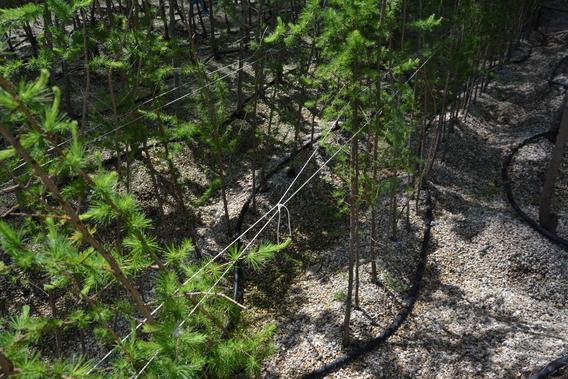
Support for trees in bed.
Measurements of success
Q. Generally, how well did plant materials survive and perform in gravel?
A. Most survival rates are good to very good. Some species would be categorized as adequate.
Q. Generally, what was the survival rate of planted gravel bed trees/shrubs one year after planting?
A. Probably 95% or more. We experience a fair amount of vandalism, car accidents, etc. When combined with the significant number of trees we plant (1200 to 1400 per year) this makes it difficult to track.
Q. If survival rates were low, do you have an opinion of why the rates were low?
A. I think harvest timing and care after harvest (before being delivered to us) can play a role when trees underperform.
Photos
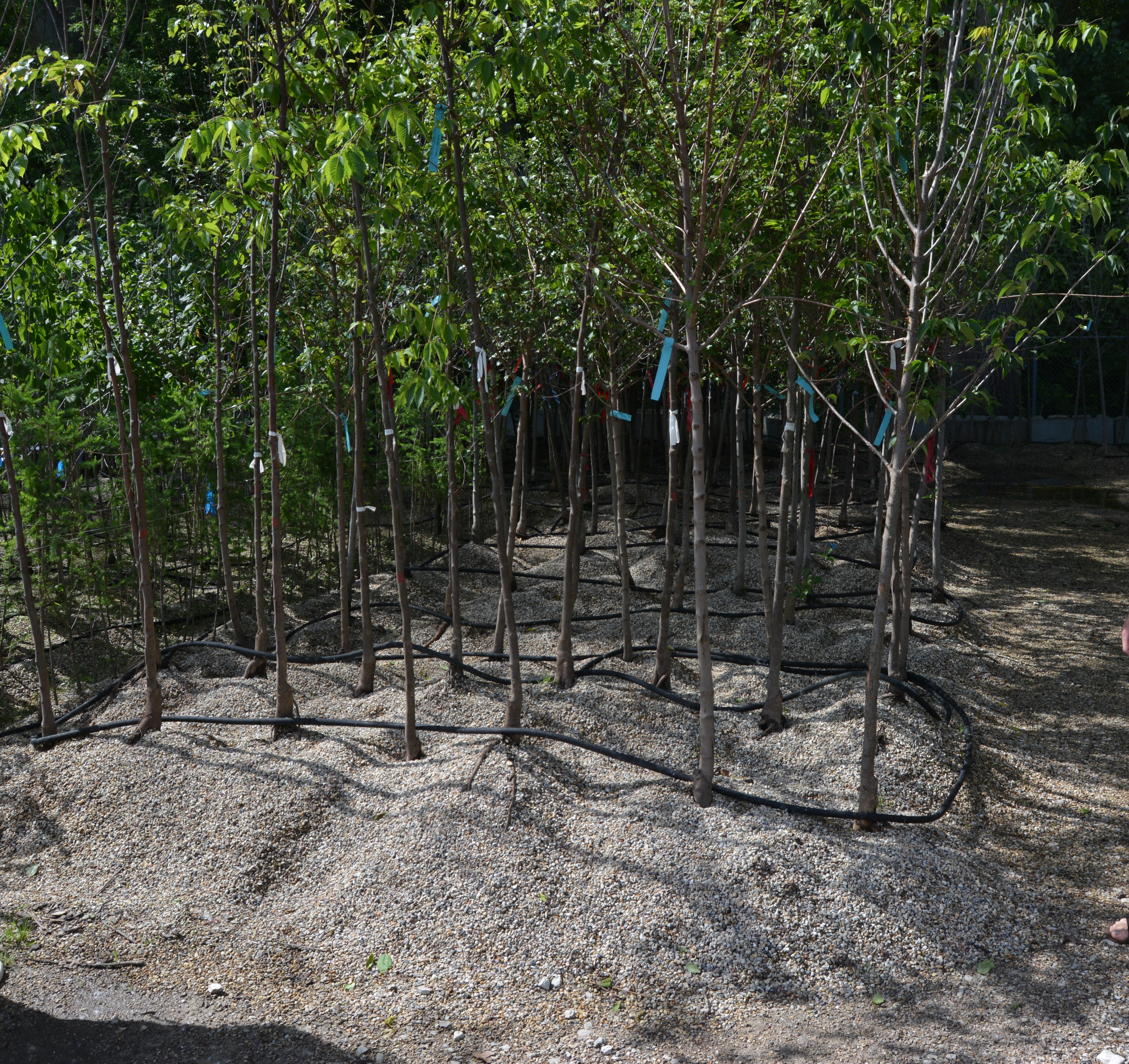
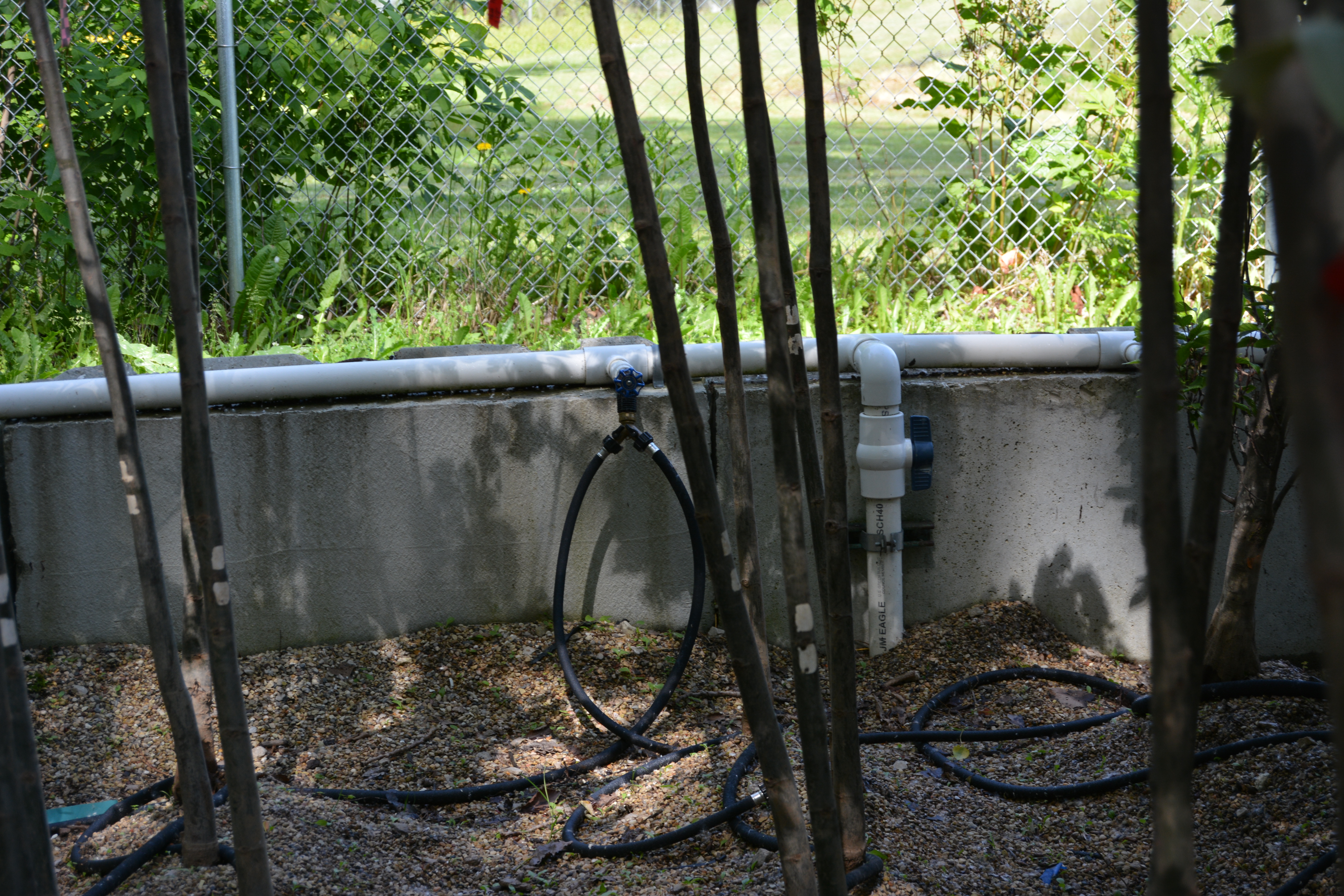
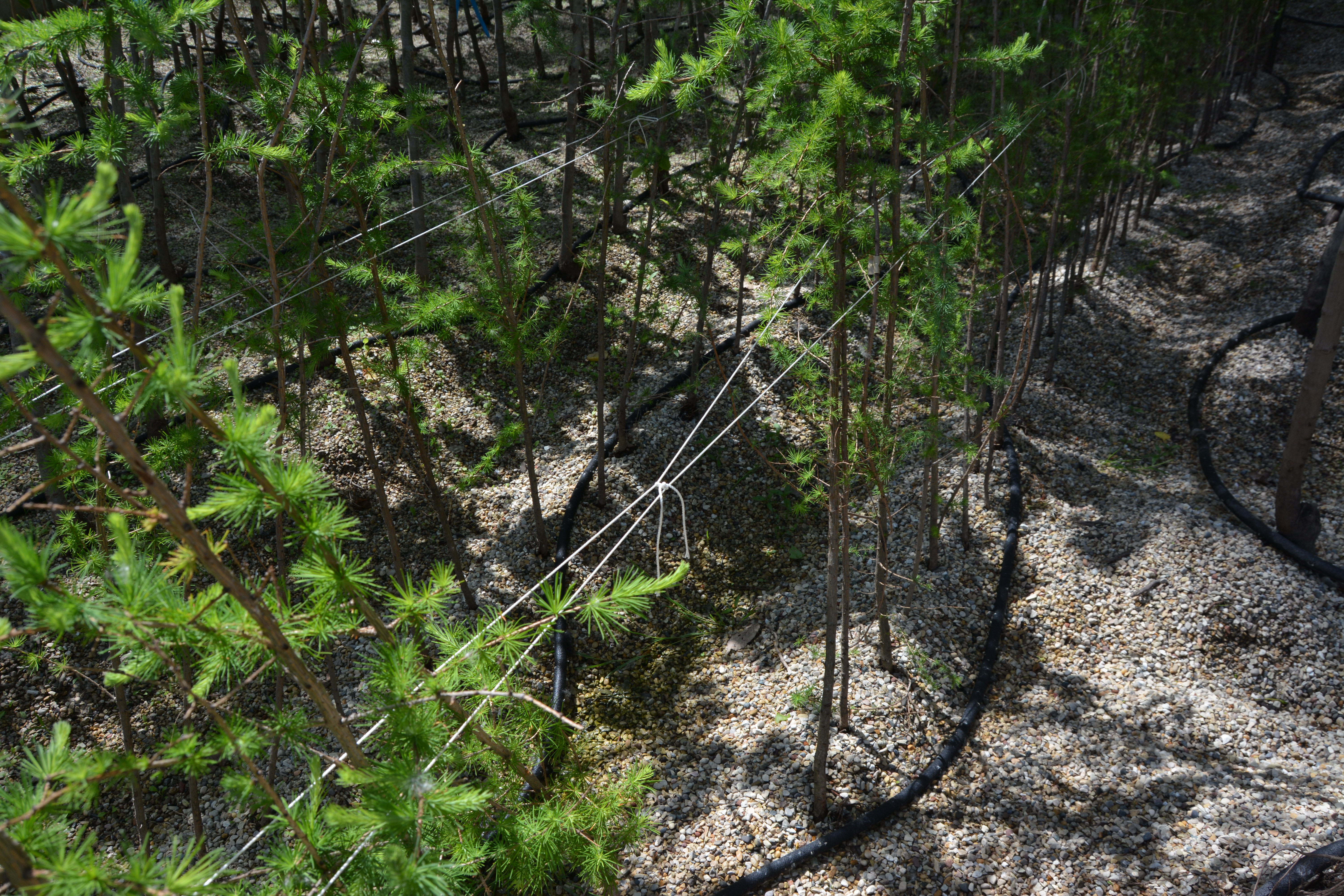
Contact information
Hennepin County Forestry, Minnesota
History of your gravel bed
The Hennepin County gravel bed was built in 2015 as a means to affordably replace removed ash trees. This first gravel bed is still being used but another was built to accommodate more trees. And another expansion is slated for Spring 2024.
These gravel beds are mostly used by County staff but we do utilize them as training tool for whomever is interested.
The structure and mechanics of the gravel bed
The gravel beds are all at our County jail site. The area is enclosed by fence and is open to sun and wind.
The first of the gravel beds was constructed with a geotextile weed barrier over soil. The subsequent gravel beds are and will be built on a concrete pad. The pads are at grade but engineered for water to flow to one single exit point. The gravel beds utilize jersey barriers to delineate the edges of the beds.
The first gravel bed 4,075 square feet, the second is 8,045, and the gravel bed to be built will be a 5,800 expansion.
We use 3/8 washed river rock or buckshot as some gravel pits call it.
We have landscape pop up sprinklers around the beds and a regular hoses with ratchet sprinklers down the muddle of the largest bed. These are all on timers to be watered 10-20 minutes 3-4 times per day depending on the wind and heat of the season. The water source is an unfiltered city source.
Management of the gravel bed
We can fit 2,000 trees in the beds now and will be able to handle 3,000 after the addition. Stocking the beds is weather dependent. Normally late April though.
Q. How often does the gravel bed get irrigated? What is the length of the irrigation time?
A. These are all on timers to be watered 10-20 minutes 3-4 times per day depending on the wind and heat of the season.
Q. Do you add any amendments to the gravel bed, e.g, fertilizer?
A. No
Q. Are weeds controlled in the gravel bed? If so, how?
A. This is one of the reasons we went to a concrete pad. We hand pick all of the weeds but may need to use herbicide to manage such a large area.
Q. Are animals a problem, e.g., rabbits, deer, voles, field mice, ground squirrels?
A. The fence helps with large herbivores but the rabbits will get the trees so we use stem protection on every tree. We use Plantra stem protection devices for the trees.
Q. Have you experienced any disease or insect problems on the plants in the gravel bed? If so, have you controlled them?
A. Japanese beetles can be an issue. We use the over-the-counter traps and empty them daily if it is a large emersion year. We were hesitant to use these as there was guidance suggesting that they attract other beetles from further away, but I found that it doesn’t matter if we eradicate the neighbors beetle issues while we are getting rid of ours. We found the traps to be very effective and had no further canopy loss after installing them.
We have found that cankers can spread pretty easily on Honeylocust so we try to keep them to the outside of the bed where there is more wind.
Rusts – Rust is especially bad on Crataegus Sp. so we try to keep those species in the open wind and sun too.
Plant materials
Q. What trees/shrubs have you held in your gravel bed?
A. The Hennepin County Forestry spreadsheet is indicative of the species we work with.
Q. What sizes of trees have you held?
A. We will hold seedlings up to 1.5” DBH. Any larger than that becomes unmanageable to keep upright, move, pull out at the end of the season, etc.
Q. Have you stocked any pot-bound, containerized trees or shrubs in your gravel bed as a method of developing expansive, non-encircling roots?
A. No, we don’t have capacity to remediate issues.
Harvesting plant materials
Q. How long do you leave plants in the gravel bed before harvesting?
A. We have no set time that they must be in the gravel bed. The gravel bed is as much a holding area as it is a root enhancement treatment. That said, I won’t keep trees in the bed for more than 2 growing seasons.
Q. How do you harvest the plant materials?
A. We install and remove using a front end loader with a standard bucket.
Q. When plants are harvested, how are the roots protected from drying out?
A. All trees are kept in a trailer until planting time unless it is a volunteer planting or such a large planting that we need to lay stock out. In those cases we use a 55 gallon container that is partially filled with soaked mulch. Each tree gets placed in the container and the soaked mulch gets dumped in it. This is also a nice way to have mulch at every hole for a volunteer planting.
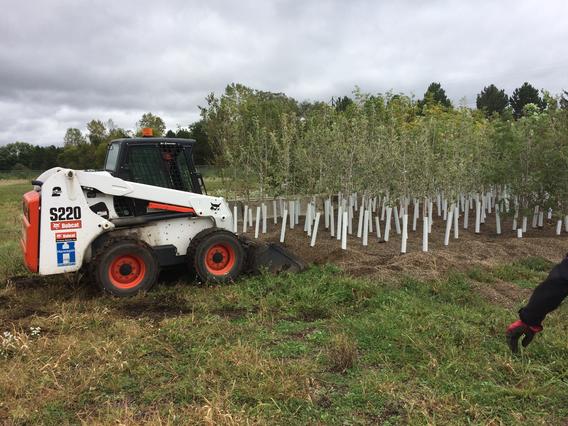
Harvesting with a front-end loader.
Photo: Dustin Ellis
Measurements of success
Q. Generally, how well did plant materials survive and perform in gravel?
A. We have very good results in the gravel bed. Less than 2% mortality.
Q. Generally, what was the survival rate of planted gravel bed trees/shrubs one year after planting (by species if possible)?
A. Sorry, we plant too many trees to give you specific species mortality. I would say we have a 90% survival rate in the landscape.
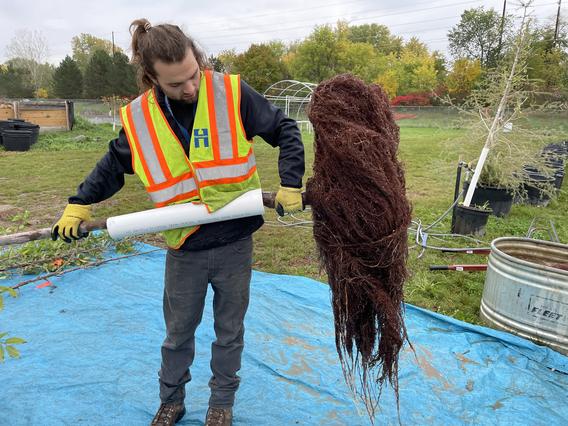
Example of gravel bed tree root system.
Photo: Dustin Ellis
Lessons learned
Do not build a gravel bed on bare ground if it is going to be so large that you need excavators to remove the trees. The tracks or wheels will get mud integrated into the gravel and after a few years, the media is a no longer gravel or soil…its just a mess.
Species list
Photos
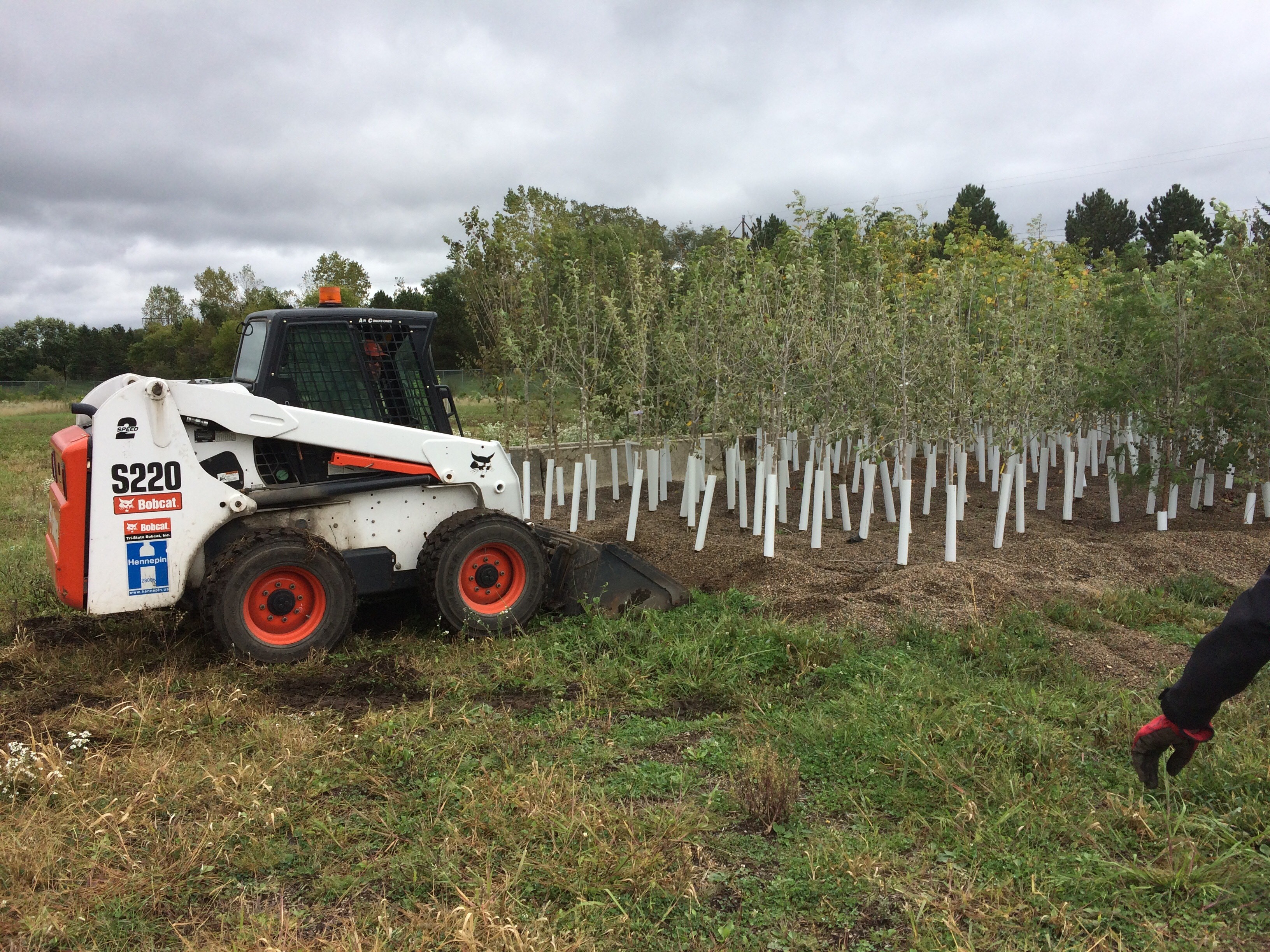
Harvesting with a front-end loader.
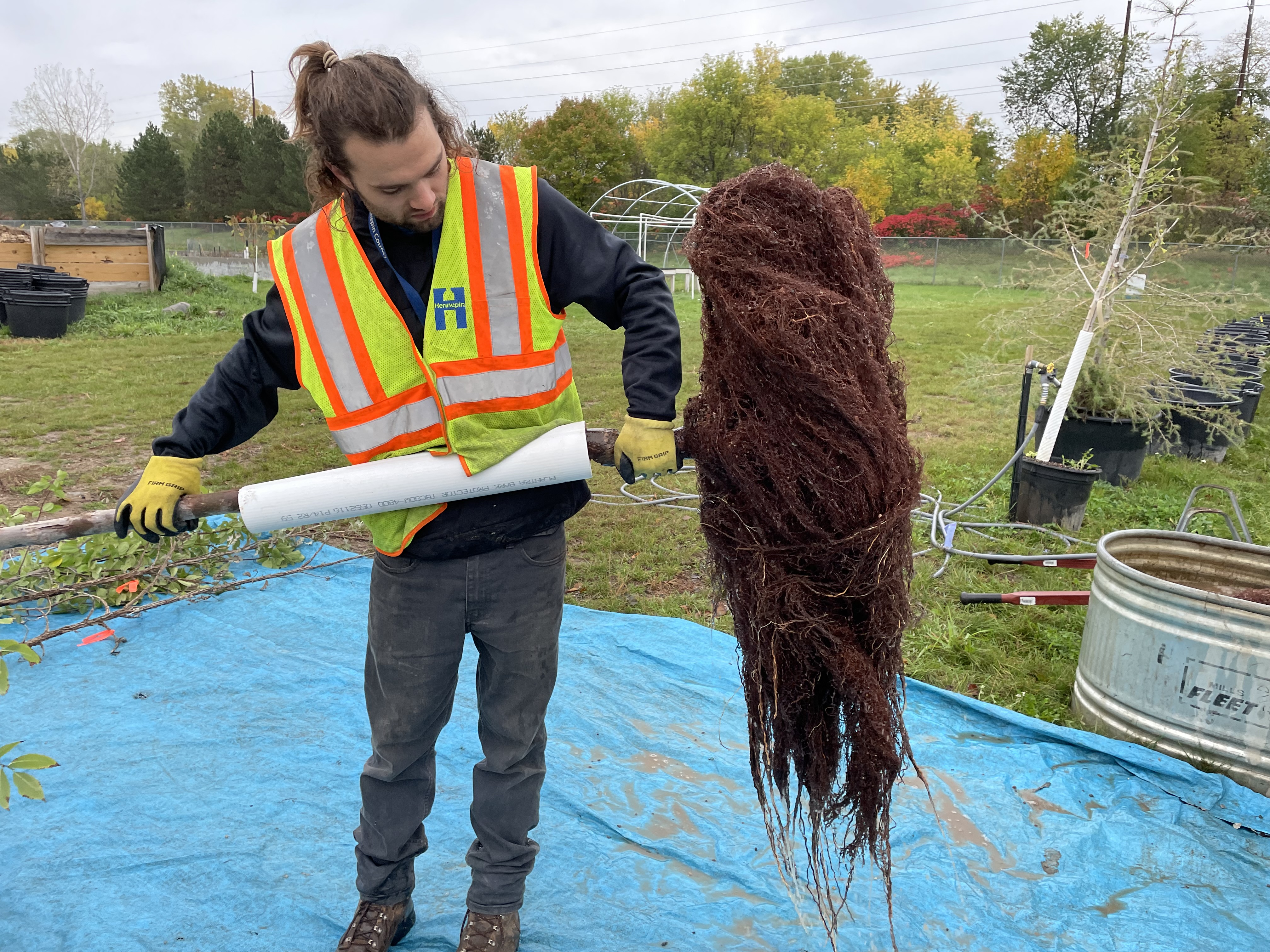
Example of gravel bed tree root system.
Photos by Dustin Ellis.
Contact information
Washington County, Minnesota
History of your gravel bed
The gravel bed nursery at the Washington County fairgrounds is a project that is a collaboration between the Washington County Conservation District, Washington County Fair board, Minnesota Water stewards, Climate Action Corps (community forestry program) and the Washington County Master Gardener Volunteer Program Tree Squad. The grant for this project was generously provided in 2022 by North Woods and Waters of the St. Croix heritage area. The bed was built in 2023, we maintain a small description sign at the bed with a QR code that lists current information.
https://washingtoncountymg.org/gravel-bed-tree-nursery/
Our main purpose is to provide a demonstration gravel bed nursery to provide education for the public.
We are focused on those species that are native trees for our changing climate, good for pollinators, provide food for animals, help us build out various “tree trek” exhibits in parks and are considered good candidates for a gravel bed tree nursery. For example our plan for 2024 includes planting two types of Dutch Elm Disease (DED) resistant Elm trees so we raise awareness about these new varieties and the public may consider planting more of them. We are also going to experiment with small shagbark hickory trees as we have little information on how they perform in a gravel bed. Shagbark hickories are also on the list of twin cities metro native yard trees for our changing climate.
We plan to donate trees to the non-profit organizations that can use them and care for them within Washington County.
The structure and mechanics of the gravel bed
The bed sits in an open sunny area on poor soil. We are part of a larger exhibition garden called the Fairest Garden which contains many different types of gardens on dis play to the public. More information can be found here for the overall summary of the Fairest Garden and where the GBTN is located within this garden.
Washington County Gravel Bed Website
We used AC2 4”x4” critical structure cedar tone pressure treated timbers for construction. The bed is a trapezoid of 10’x8’x11’x12’ that is 17” high providing 100 square feet of bed area. We lined the bottom with heavy duty weed barrier and also a cross bar for stability. The outside has 4’ rebar pounded in place every two feet to help with stability of the frame. Photo’s on website above. We used 7 tons (4.6 cubic yards) of bulk river rock - 3/8” which filled our bed to a depth of 15”.
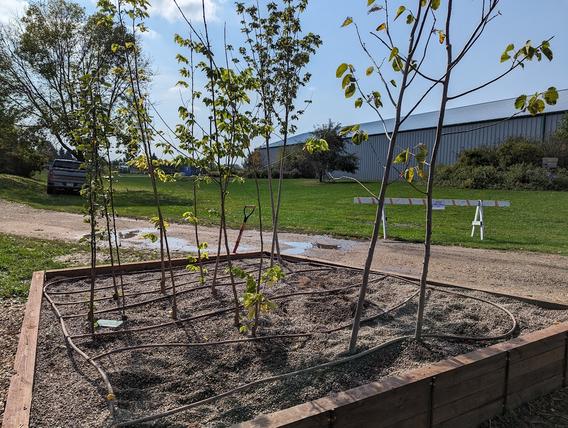
Our water source is well water from the fairgrounds water system that is filtered within our irrigation loop. We have a dedicated controller, water line to the bed and a drip line within the bed. Our drip line has ~75 0.6GPH emitters spaced every 12 inches. Our system comes on 4 times/day; 2AM, 8AM, 2PM and 8PM. We are still experimenting with water times. This first year we started with 90 min/cycle but over time reduced it to 20 min/cycle. Gravel was always moist 4-6” into the bed. The 20 min./cycle was later in the fall when weather was cooler.
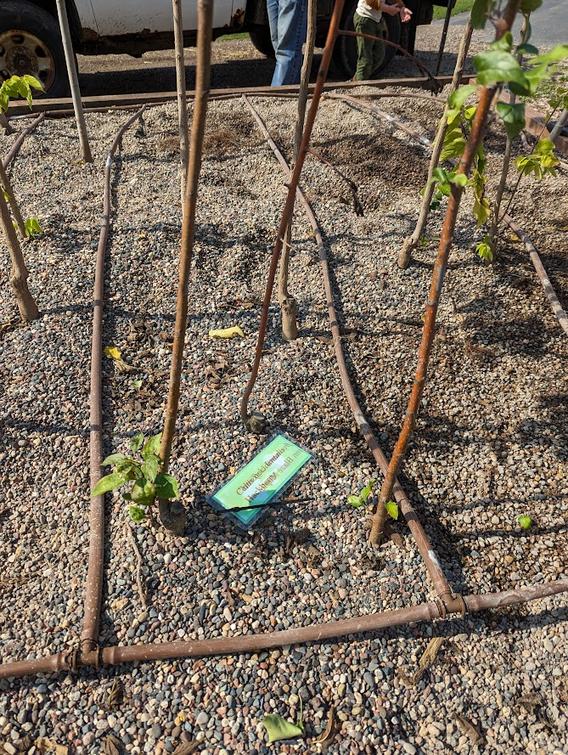
Management of the gravel bed
Q. What is the stocking level of your gravel bed?
A. Our first year, 2023, we stocked 61 trees.
- 30 5-12” bur oak trees from the Washington Conservation District tree sale in late April
- 31 larger trees to showcase the bed (chestnut crabapple, hackberry, linden and maple)
Q. When do you stock the gravel bed?
A. April for bur oaks, middle of May for bigger trees as they arrived from our supplier.
Q. How often does the gravel bed get irrigated? What is the length of the irrigation time?
A. 4 times/day - we are still learning about how long to run the system - see above.
Q. Do you add any amendments to the gravel bed, e.g, fertilizer?
A. No
Q. Are weeds controlled in the gravel bed? If so, how?
A. No - we didn’t see any this first year.
Q. Are animals a problem, e.g., rabbits, deer, voles, field mice, ground squirrels?
A. No - we were expecting deer issues but had none.
Q. Have you experienced any disease or insect problems on the plants in the gravel bed? If so, have you controlled them?
A. Japanese beetles were pervasive, especially on the lindens.
Plant materials
Q. What trees/shrubs have you held in your gravel bed? What sizes were the trees?
A. Malus (Chestnut crabapple) - Wh 4’
Celtis occidentalis (common Hackberry) - LB 4’
Tilla americana boulevard (American Linden) - 1”
Acer X free (Freeman Maple) - 1”
Quercus macrocarpa (Bur Oak) - 5-12”
Q. Have you stocked any pot-bound, containerized trees or shrubs in your gravel bed as a method of developing expansive, non-encircling roots?
A. No
Harvesting plant materials
Q. How long do you leave plants in the gravel bed before harvesting?
A. From late April/Mid May until Sept 30th. (~21 weeks)
Q. How do you harvest the plant materials?
A. Undercutting and digging them out with a pitchfork and another person rocking the tree loose.
Q. When plants are harvested, how are the roots protected from drying out?
A. We dipped all trees in hydro-gel solution and placed them in a plastic bag for transport. Most beneficiaries of the trees planted them the same day.
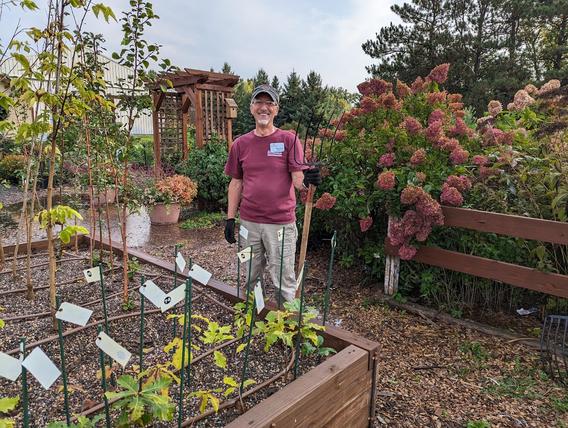
Measurements of success
Q. Generally, how well did plant materials survive and perform in gravel?
A. Very good - all trees developed fibrous root systems compared to what we observed in the spring when we planted them. Note: we intentionally picked trees from Gary Johnson’s paper that had either been rated Excellent or Very Good for gravel bed suitability.
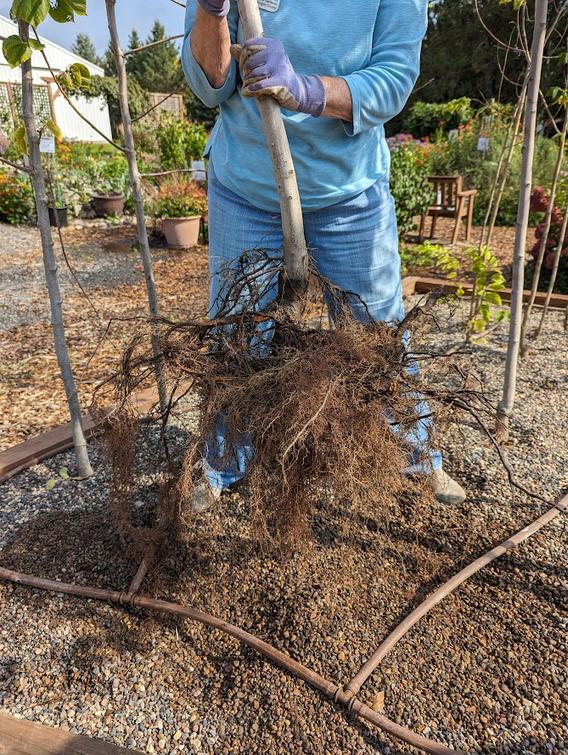
Q. Generally, what was the survival rate of planted gravel bed trees/shrubs one year after planting (by species if possible)?
A. We lost one chestnut crabapple and one hackberry so 59/61 = 97% survival. All our trees were donated to non-profits in the area so we also plan to check on survival rates during the next year or so.
Species list
Photos




Photos by Jeff Murray
Contact information
Scandia and Bone Lake, Minnesota
History of your gravel bed
It was prompted after Bone Lake experienced a tornado in 2019 but put on hold till after the pandemic. John Goodfellow had introduced me to the Marine on St. Croix community gravel bed.
The gravel bed is managed by the City of Scandia Public Works, Bone Lake Association, with planning in 2022 and the first year of operation in 2023.
The structure and mechanics of the gravel bed
It is sited on city property next to the fire station, mostly fun sun, located on soil. It is near other municipal structures and not fenced in.
The gravel bed is constructed with pressure-treated 2x10 lumber, with 4x4 and 4x6 inch inside bracing, four-sided and completely above ground. The outside dimensions are 10 feet by 20 feet and is lined with geo fabric to prevent the gravel from being “lost” in the subsoil and the subsoil mixing in with the gravel. Pea stone (3/8 inch washed gravel) was the rooting media used.
Irrigation for the gravel bed was provided by city water, sourced about 50 feet away and unfiltered. Two sprinkler heads were controlled by a timer to parse out the water.
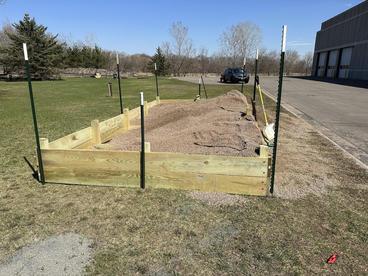
Management of the gravel bed
Q. What is the stocking level of your gravel bed?
A. 45 purchased bare root stock as well as willow and redosier dogwood cuttings in 2023.
Q. When do you stock the gravel bed?
A. April in 2023
Q. How often does the gravel bed get irrigated? What is the length of the irrigation time?
A. 2X per day for 1 hour
Q. Do you add any amendments to the gravel bed?
A. No
Q. Are weeds controlled in the gravel bed? If so, how?
A. No weed control
Q. Are animals a problem, e.g., rabbits, deer, voles, field mice, ground squirrels?
A. No
Plant materials
Q. What trees/shrubs have you held in your gravel bed?
A. Sugar Maple
River birch
Flowering Crabapple
Serviceberry
Canada Red Cherry
Weeping Willow
Black Willow
Q. What sizes of trees have you held? What sizes of shrubs have you held?
A. Trees were 6-12 feet high, Shrubs were 3-5 feet high
Q. Have you stocked any pot-bound, containerized trees or shrubs in your gravel bed as a method of developing expansive, non-encircling roots?
A. No
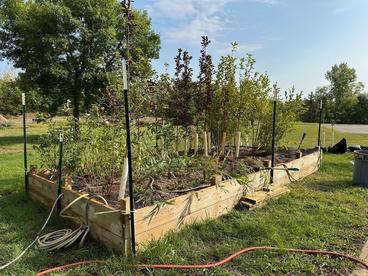
Harvesting plant materials
Q. How long do you leave plants in the gravel bed before harvesting?
A. All harvesting was done in late September and early October
Q. How do you harvest the plant materials?
A. Pulling out when possible, or digging out with shovels for most.
Q. When plants are harvested, how are the roots protected from drying out?
A. All trees were placed in plastic bags after dipping in hydrogel
Measurements of success
Q. Generally, how well did plant materials survive and perform in gravel?
A. Generally excellent. The sugar maples did not fare well, but the supplier replaced them. The redsosier dogwood did not survive
Q. If survival rates were low, do you have an opinion of why the rates were low?
A. The sugar maple and dogwood were both near the edge and may have lacked water.
Lessons learned
Change the irrigation method
Photos
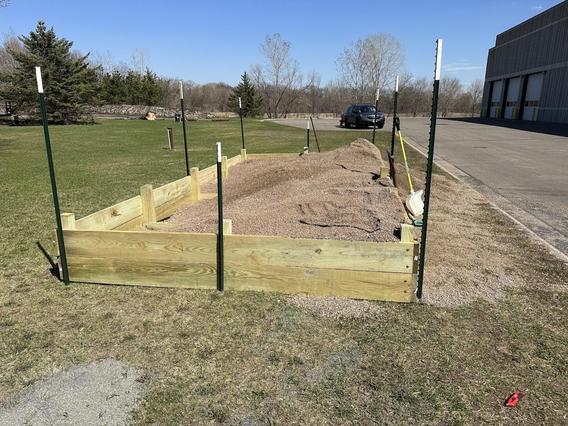
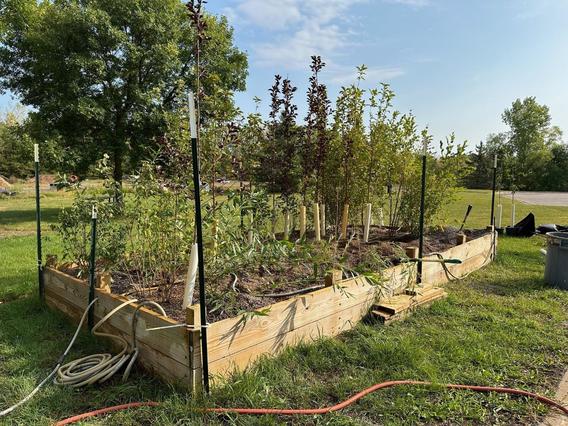
Contact information
Shawnee County Kansas, Parks and Recreation
History of your gravel bed
We have been trying to increase the number of trees being planted in our park system. The problems that we have been experiencing have really limited our efforts. The problems have mainly been:
A. High cost of container and balled in burlap nursery stock.
B. Poor quality of nursery stock.
C. Heavy weights and labor requirements.
So we have been exploring other options. We have re-started our in-ground field nursery which was initially stocked with small bare root whips and then moved out into the parks when they reached a large enough size. We have a 44” tree spade that we use for that.
I first heard about Missouri gravel beds around 2012 when Professor Chris Starbuck from the University of Missouri spoke at the Kansas Arborists Association Shade Tree Conference. Then over the past several years I have been doing some online research and came across the publications of Professor Gary Johnson from the University of Minnesota.
We have not had any involvement by outside entities mainly because we did not seek any help. It has been built entirely in house by park staff.
The structure and mechanics of the gravel bed
Our bed is located at or maintenance facility which is one of our larger parks. It is at the south end of one of the buildings. It is shaded on the east by a row of cedar trees and in late afternoon by a catalpa tree about 40’ to the west.
At the present time it is half on concrete and half on soil. This past year was our first year with the gravel bed, so it was kind of an experiment. We are now in the process of putting it all on concrete. Our compound area is surrounded by an 8’ tall wooden privacy fence so we do not have any problems with vandals or deer.
It is enclosed on the north side by our building foundation and on the other three sides by versa-lock landscape blocks. It is above grade and the walls are 18” tall. The bed is rectangular in shape measuring 16’x26’ (416 sq ft). The bed is filled with 5/8” washed river pea gravel with no sand or amendments added.
Our water source is municipal water from a river and a frost free hydrant about 12’ from the bed. The water is not filtered. The irrigation this first year has been with a simple oscillating lawn sprinkler on top of a 55 gallon barrel in the middle of the bed. It was controlled by an inexpensive timer.
Management of the gravel bed
Q. What is the stocking level of your gravel bed?
A. We had about 120 trees in the bed last year.
Q. When do you stock the gravel bed?
A. We install about April when the nursery ships our bare root tree order.
Q. How often does the gravel bed get irrigated?
A. Our irrigation timer is set for 15 minutes each, 4 times a day.
Q. Do you add any amendments to the gravel bed?
A. No amendments or fertilizers are added.
Q. Are weeds controlled in the gravel bed?
A. We pull some of the larger weeds that sprout up, but we did not have much problem with weeds at all.
Q. Are animals a problem, e.g., rabbits, deer, voles, field mice, ground squirrels?
A. We had no problems with animals.
Q. Are any protective devices used to minimize animal damage, such as rabbit fencing, stem guards?
A. No.
Q. Have you experienced any disease or insect problems on the plants in the gravel bed?
A. We have not.
Plant materials
Q. What trees/shrubs have you held in your gravel bed?
A. We had a large variety of trees. The largest amounts was Box Elder, London Plane trees, and hybrid Elms.
Q. What sizes of trees have you held? What sizes of shrubs have you held?
A. The trees ranged from 3’ whips to 2.5” caliper. No shrubs.
Q. Have you stocked any pot-bound, containerized trees or shrubs in your gravel bed?
A. Yes, actually we have done a lot. A local nursery garden store has donated overstocked container and B&B trees for several years now. These trees have been held for too long and have been very pot bound. We pull the trees out of the pots and completely strip the soil medium away. We then prune the root system to eliminate circling, kinked, and misshapen roots. The B&B trees have all the soil removed. There is very little if any root pruning needed on these trees. The trees are then placed in the gravel bed in the spring. We lost a few of the trees, but overall the results were very good. Two of the B&B trees were hybrid elms that had been stored for at least a year. They measured about 2.5 “ caliper and about 14’ tall. When we stripped the soil off these, all that was left was some short stubby roots. When we pulled them from the gravel 5 months later the root ball looked like a giant wig. The re-growth of the root mass was amazing.
Harvesting plant materials
Q. How long do you leave plants in the gravel bed before harvesting?
A. We leave them in gravel for about 5 months.
Q. How do you harvest the plant materials?
A. For harvesting we remove one wall of the bed and use a small front loader to remove trees. The gravel is taken out and moved to a separate holding area until it is time to re-stock the gravel bed.
We use several different attachments to dig the trees out depending on the size of the trees. On small trees pallet forks with the forks moved close together works well to just loosen the gravel as the trees are being pulled out by hand. For larger trees we either use a light materials bucket or a brush grapple. We are planning on purchasing a rock sifter attachment also.
Q. When plants are harvested, how are the roots protected from drying out?
A. Last year we just placed them in a truck bed and kept them wetted down with a spray nozzle on a garden hose. When we was done harvesting we covered them with wet burlap. In the future I plan on using a hydrogel and put them in plastic bags.
In our park system we try to plant trees larger than 1” caliper. The smaller caliper trees get taken out of gravel and planted in our field nursery where they will be grown to a larger size, then moved out into the parks with our 44” tree spade.
Contact information
Darrel Hansford
Forester - Shawnee county Parks and Recreation
Email: [email protected]
Phone: 785-207-3389